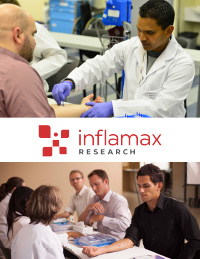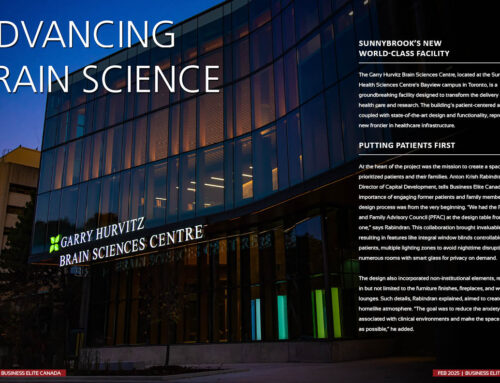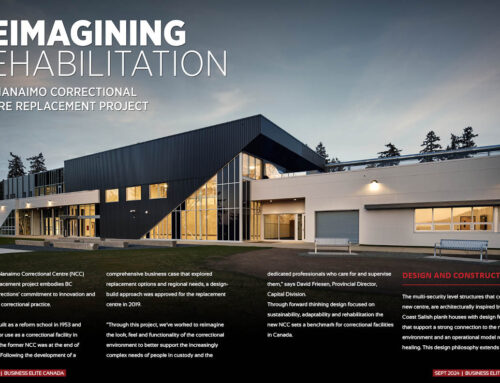Awe-inspiring science by Canadian entrepreneurs
By Rajitha Sivakumaran
Innovative technology, cutting-edge research, global impact — these are descriptors often associated with organizations south of the border or across the ocean. Little does the public know that Canada is very much capable of occupying a leadership position in the global research market. One Ontario-based company, Inflamax Research, has been demonstrating exactly that for the past four years.
Founded in 2012 by world-renowned allergy and asthma specialist Dr. Piyush Patel, Inflamax is a full-service Clinical Research Organization (CRO). Clinical trial research is only one aspect of the company’s services. Oftentimes, Inflamax is involved in the entire project, from start to finish. This involves everything from designing the study to carrying it out and analyzing the results and demands the input of clinicians, data management experts, biostatisticians and medical writers.
The company’s specializations are numerous: asthma, dry eye syndrome, allergy, and more. The latter, in particular, is an affliction endured by a vast number of people around the world. With a background in biochemistry, physiology and pharmacology, Dr. Anne Marie Salapatek, Inflamax’s President and Chief Science Officer, knows better than anyone about the detrimental effects of allergies. Though regarded as a commonplace ailment, allergies can lead the way to other diseases like asthma, and severe allergic reactions can cause anaphylaxis and even death.
“The World Health Organization has indicated that allergy is increasing in epidemic proportions. We really have to understand the mechanisms behind this if we’re going to understand how to avoid it or minimize it,” Dr. Salapatek said.
Innovative solutions for a worldwide problem
The company’s claim to fame is attributable in part to the Environmental Exposure Chambers (EEC) first utilized by a contract research organization by Dr. Patel. The EEC is a specialized facility, built to mimic the natural world, acting as a simulation of exposure allergy patients would face in their everyday life. Using traditional methods of studying allergy patients (i.e. studying them as they go about their lives) is tricky business due to the high variability of environments — for example, there is a stark difference in the allergen exposure of a gardener compared to that of an office worker. Furthermore, the climate has taken a turn towards unpredictability, the consequence of which is erratic pollination. So the natural environment itself can’t serve as a controlled setting for allergy experiments.
EECs allow researchers to introduce select allergens, like dust, to patients in a controlled, safe and naturalistic fashion. Patients are observed in these chambers prior to starting a drug trial in order to gauge the severity of symptoms. A treatment plan is then introduced, followed by a re-examination, during which time data can be collected on the efficacy of a medication.
Some may say that treatment already exists for allergy patients, conveniently sitting on the shelves of pharmacies, but Dr. Salapatek described traditional allergy treatments, like antihistamines, as band-aid solutions. Her research focus lies with unveiling the underlying mechanisms of allergy.
The chambers are particularly helpful when studying allergy immunotherapies — a new class of allergen-specific medications that target allergy mechanisms. Dr. Salapatek and her team are in the process of testing an allergen-specific therapy for grass. The problem is this: most people are not allergic simply to one thing. EEC technology allows the team to expose patients to only grass-related allergens in order to test the efficacy of the therapy. The project is the first of its kind in the world, using over 250 patients and 20 clinical investigators, and mobile EECs — transportable units, where everything needed to carry out the study can be packed up into an intermodal container. The chamber itself is an inflatable system. With two installations in Cincinnati and New Jersey, the company is doing the world’s first multi-centre mobile chamber study across the U.S. right now.
Having worked with clients and sponsors across Canada, the U.S., Europe and South Africa, Inflamax is now planning to conduct EEC studies in Japan towards addressing the Japanese government’s call to develop new allergy medications to deal with the high level of allergy in Japan. Future plans entail taking the EECs to Europe and expanding its utility to other diseases like asthma.
Creative scientists, successful entrepreneurs
When the company first emerged, it did so with only a handful of employees. Four years later, the staff count has reached over 400. So what distinguishes Inflamax from the rest? According to Dr. Salapatek, it’s their scientific know-how. The team is made up of professionals who are world leaders in their area of expertise. Dr. Salapatek herself has spent over 20 years conducting research for both the academic and industrial sectors.
Often, it is difficult to move from academia to industry, but despite coming from a strictly scientific background, Dr. Salapatek transitioned into the entrepreneurial aspects of Inflamax rather easily. “You can’t be bound by an occupational description,” Dr. Salapatek said. She has benefitted immensely from the leadership of Dr. Patel, a scientist who is well-versed in the business world.
“We have built our company organically and grown it organically and we’ve really tried to employ managers who have good leadership skills,” Dr. Salapatek said.
The record amount of growth Inflamax has experienced in as little as four years is attributable to its exceptional management. Last year, Inflamax was recognized as one of Canada’s Best Managed Companies by Deloitte. The company’s approach is a simple one: managers are encouraged to operate their unit of Inflamax in an entrepreneurial style, whereby innovation is fuelled autonomously.
A common trend seen amongst successful companies is a motivated staff and Inflamax is no exception. “An important part of our success has been that everybody who works here is very, very passionate about what they do,” Dr. Salapatek said.
Recently, Inflamax was selected to go on a trade mission with the Ontario government to Israel. As Israel is a hotbed of research activity, Dr. Salapatek expressed her excitement at the prospect of working with an Israeli client to develop new equipment that will enable researchers to examine the tear film of those suffering from dry eyes.
The science-business combo can yield unique challenges too. “We’re a very innovative company, but we’re operating as an innovative company within a highly regulated space,” Dr. Salapatek said.
Naturally, these regulations are not without reason. Researchers are conducting tests on live subjects and this demands safe practices and a strict amount of scrutiny, but heavy regulation can sometimes hinder productivity and progress. Overcoming this difficulty simply entails demonstrating the utility of the company’s innovative solutions to regulators.
The company’s plan is to continue producing cutting-edge research and expanding into the peripheries of the market, all the while distinguishing itself as a Canadian-born innovation.
www.inflamaxresearch.com







